Joseph Ratzinger He was born in 1927 in the Bavarian town of Marktl am Inn, the son of a rural policeman who moved numerous times during the first 10 years of the life of the until now Pope. He was a deeply believing Catholic and hostile to National Socialism: “He saw with incorruptible clarity that Hitler’s victory would not be a victory for Germany, but for the Antichrist” “.
Family ideology did not prevent Ratzinger from having to join the Nazi youth and serve during the war in the anti-aircraft batteries that protected a BMW aircraft engine factory. Although he could refuse to enlist in the SS. Between May and June 1945 he was a US Army prisoner of war.
Like Karol Wojtyla, the experience of Nazism is key in shaping his thought. From the example given by part of the Catholic hierarchy in compromising with Hitler, he drew the conviction that “the Church cannot agree with the spirit of the times”.
Ratzinger, Professor of Theology since 1959, at the age of 32, companion of Hans Küng and professor of Leonardo Boff, He was a consultant during the Second Vatican Council to the Archbishop of Cologne, Joseph Frings. He is credited with the intervention of the cardinal in which he described “source of scandal” the Holy Office, the Vatican inquisition that under another name he ended up directing. He was editor together with Karl Rahner of documents on the renewal of the liturgy, or the collegial government of the Church.conciliar concern
But the conciliar euphoria soon gave way to concern. “At the council there came in,” he wrote years later, “something of the breeze of the Kennedy era, of that naive optimism of the idea of a great society: we can achieve everything, if we set our mind to it and provide the means for it”. However, he came to the conclusion that “the pieces of the old building were torn apart and another was not built” and that “the overturning of the Church in the world could not lead to a renewal of the Church, but simply to its end”.
Especially concerned by the idea of ”popular ecclesial sovereignty” and the primacy of theologians over bishops, In his transformation -and in some of his later concerns- the student revolt of 1968 with which he had to deal at the University of Tübingen, played a key role. where leaflets were distributed describing Jesus as a “guerrilla”. “The Marxist revolution ignited the entire university, it shook it to its foundations…. I have seen the cruel face of this atheistic return uncovered, the psychological terror, the debauchery with which any moral reflection was renounced.”
From the renewal, Ratzinger goes to the recovery of the concept of “obedience”, since the Church “is not a party, it is not an association, it is not a club, its deep structure is not democratic, but sacramental, and therefore hierarchical”.
The ‘grand inquisitor”
Ratzinger, Archbishop of Munich since 1977, met Karol Wojtyla in 1978, during the conclave in which John Paul I was elected. He was not appointed Prefect of the Congregation for the Doctrine of the Faith until November 1981. His first step was settle the work of the mixed commission that had a very advanced confluence between Anglicans and Catholics. His role as guardian of orthodoxy becomes clear in 1983, when the disappearance in the Canonical Code of the traditional condemnation of Freemasonry is followed by an immediate clarification that reminds us that belonging to it is a “grave sin”.
The helmsman of the boat
Ratzinger he will be remembered for his crusade against liberation theology. The list of reprisalized theologians, such as Leonardo Boff or Hans Küng, is endless. Listening to the defendant (five hours of interview with Boff) but without contemplation, because “The word of God has never been kind and charming.” But his role as guardian of orthodoxy went even further. In the year 2000, the year of John Paul II’s request for forgiveness, Ratzinger mortally wounded the ecumenical dialogue with his document ‘Dominus Iesu’, which ruled that the Catholic Church is the “only path of salvation”. And in 2003, he writes the document that instructs Catholic politicians to oppose laws on abortion, euthanasia or gay marriage.
Dean of the college of cardinals since November 2002, Ratzinger was the true ruler of the Church with the vacant see. If on other occasions we had to wait for the inaugural mass of the pontificate to learn about the program of the new Pope, Benedict XVI He was already able to expose it at the funeral of John Paul II and at the mass prior to the conclave, when he drew Catholicism as a “small boat” buffeted by currents that would end up passing: “From Marxism to liberalism, to licentiousness, from collectivism to radical individualism, from atheism to a vague religious mysticism; from agnosticism to syncretism.” Because, as he said on one occasion in Pamplona, at the presentation of the book interview with Peter Seewald ‘The salt of the earth’ before a group of journalists who surprised us by his attitude of self-critical dialogue rather than admonition, “a time of regression It can serve to mature new forces”.
Related news
Between 1991 and 1993, Ratzinger suffered minor strokes, from which he recovered. In 1997, his autobiography as a cardinal ended thus: “I walk with my load through the streets of the Eternal City. When I will be released, I do not know.” It seems that now.
This is a republished version on the occasion of the death of Benedict XVI of a profile published on February 11, 2013 on the occasion of his resignation as Supreme Pontiff
The evolution of Joseph Ratzinger: from Vatican II to the Holy Office, dragged down by pessimism

